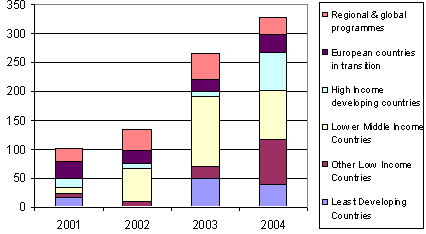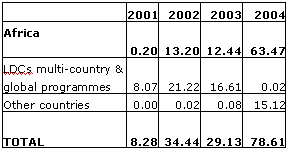- home
- wto news
- 2005 press releases
- press release
WTO: 2005 PRESS RELEASES
Press/427
12 December 2005
TECHNICAL ASSISTANCE
Aid for trade capacity in poorer countries up by 50 per cent since Doha
The amount of trade-related technical assistance and capacity building ?to help developing and least-developed countries to participate more efficiently in international trade ?has increased by 50% since the Doha Ministerial Declaration in November 2001, according to a joint report by the WTO and the OECD.
> More
on Technical Cooperation
SEE ALSO:
> press releases
> WTO news archives
> Pascal
Lamy's speeches
The amount of trade-related technical assistance and capacity building (TRTA/CB) ?to
help developing and least-developed countries to participate more
efficiently in international trade ?has increased by 50% since the Doha
Ministerial Declaration, in November 2001. As donors become increasingly
active in this area, aid for trade capacity has grown to some 4.4% of
total aid commitments of the world抯 major contributors, according to a
joint report by the World Trade Organization (WTO) and the Organisation
for Economic Co-operation and Development (OECD).
The report draws from a joint WTO/OECD database on trade capacity
building available at
http://gtad.wto.org. This database, launched in November 2002, now
contains almost 15 000 activities covering the period 2001-2006, and
consolidates trade-related aid commitments in the areas of capacity
building and technical assistance, reported by more than 40 bilateral
donors and multilateral agencies.
Assistance is provided within three categories:
-
Trade policy and regulations ?to help countries reform and prepare for closer integration in the multilateral trading system ?up from USD 0.65 billion in 2001-02 to USD 0.85 billion in 2003-04;
-
Trade development ?to help enterprises to trade and create a favourable business climate ?up from USD 1.3 billion to an average of USD 2.1 billion over the same period; and
-
Infrastructure ?to help countries build the physical infrastructure to produce and move goods and export them ?some USD 9.3 billion in 2003.
The report includes the results of a survey that shows that donors have become much more active in this area over the last few years ?through increased funding; explicit strategies and programming guidelines to develop trade; more awareness of the role of trade assistance in poverty reduction; and strengthened dialogue between development and trade practitioners.
THE TRADE CAPACITY BUILDING DATABASE
http://tcbdb.wto.org
HIGHLIGHTS
2005 Joint WTO/OECD Report on Trade-Related Technical Assistance and Capacity Building (TRTA/CB)
The joint WTO/OECD Trade Capacity Building Database (TCBDB) contains
almost 15 000 activities covering the period 2001 ?2006 and reported by
more than 40 bilateral donors and multilateral agencies. The report
presents an overview of Trade-Related Technical Assistance and Capacity
Building (TRTA/CB) committed between 2001 and 2004, based on data
reported to the TCBDB.
Trade-related assistance is categorised under three headings:
-
trade policy and regulations ?to help countries reform and prepare for closer integration in the multilateral trading system;
-
trade development ?to help create a favourable business climate; and
-
infrastructure ?to help countries build the physical infrastructure to move goods and export.
Chart 1 ?Distribution of TRTA/CB and infrastructure
by region and main category ?USD million

Since the Doha Ministerial Declaration, total assistance to trade capacity building has increased by 50%:
-
Aid committed to assist beneficiary countries with trade policy and regulations increased from a base of USD 0.65 billion in 2001-02 to an average of USD 0.85 billion in 2003-04, while over the same period aid committed to trade development rose from a base of USD 1.3 billion to an average of USD 2.1 billion.
-
Least Developed Countries (LDCs) represented 16% of total commitments for support to trade policy and regulations and 20% for support to trade development, less than their 25% share, in 2003, in both categories. (1)
-
Contributions to the TRTA/CB Trust Funds (e.g. Joint Integrated Technical Assistance Programme, Integrated Framework Trust Fund, the ITC and the WTO) increased from USD 26 million in 2001 to USD 45 million in 2003 and remained stable at that level in 2004.
-
Support for economic infrastructure ?transport, energy and telecommunications ?which is essential for international trade, reached USD 9.3 billion in 2003, with an increased share for Africa.
-
In 2003, the respective shares of TRTA/CB and infrastructure in total aid commitments were 4.4% and 25%. (2)
Following commitments by the G8, EU and at the UN 2005 Summit, total
Official Development Assistance is projected by the DAC Secretariat to
increase from USD 80 billion in 2004 to USD 130 billion in 2010. With
increased attention to trade and infrastructure to help achieve the
Millennium Development Goals, the volume of assistance to help
developing countries to participate more, and more effectively, in
international trade could rise significantly in the coming years.
The report includes the results of an OECD TRTA/CB Survey. These show
that donors have become much more active in this area over the last few
years. This is reflected in increased funding; the number of donors with
explicit strategies and programming guidelines for TRTA/CB; enhanced
awareness of the importance of TRTA/CB for development and poverty
reduction; and strengthened dialogue between development and trade
practitioners. In addition, several donors have reviewed their bilateral
programmes and/or their participation in multilateral programmes to
assess the effectiveness of their TRTA/CB activities. The report also
includes a short summary ?揟CB at a glance??that provides for each
donor an overview of the volume of assistance, strategy, objectives, and
geographical and thematic areas.
The 2005 report also focuses on two significant Doha Development Agenda
developments: the launch of the WTO negotiations on trade facilitation
and the implementation of the development aspects of the cotton
initiative, and shows recent trends of assistance dedicated to these two
areas.
Trade Facilitation
Assistance to trade facilitation increased sharply and consistently in recent years. Total commitments to this category more than tripled between 2001 and 2004, to reach USD 330 million. Multilateral agencies, including the EC, are the main channel of assistance to trade facilitation. Lower Middle Income Countries ?mainly in the Balkans and North Africa ?were the main recipients of assistance to trade facilitation over the period 2001-2004, but the share and the volume of assistance to low income countries (LDCs and Other Low Income Countries) has increased since 2003.

Figures in USD million
Cotton Initiative
The table below shows the amounts committed to TRTA/CB activities identified as specifically related to cotton at the regional level that benefit the four proponents of the cotton initiative (Benin, Burkina Faso, Chad and Mali) as well as other African countries during the period 2001-2004. Total TRTA/CB related to cotton committed for Africa reached USD 63.4 million in 2004 pursuant to the agreed mandate in the July Framework Package, five times its level of 2002-2003. At the global level it reached USD 78.6 million with an increase over 2002-2003 of 150%.

Source: TCBDB
Figures in USD million
Notes:
1. This decrease is largely due to the programming
cycle of the main donors that made many new multi-year commitments to LDCs in
2003. Back to text
2. OECD estimate, calculated on sector-allocable
Official Development Assistance (ODA). 2004 data are not yet available.
Back to text
